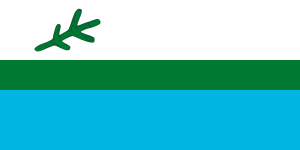Flag of Labrador

The flag of Labrador, while unofficial, is used to represent the mainland part of the Canadian province of Newfoundland and Labrador as distinct from the island of Newfoundland. It was designed in 1973 by Michael S. Martin. The flag has been influential in Labrador; its colours are mirrored in the flag of Nunatsiavut, and its spruce twig was adopted for use on the Franco-Terreneuvien flag.
Impetus
In 1973, the government of Newfoundland asked the citizens of the province to adopt special projects to commemorate the event of the 25th anniversary of Newfoundland’s 1949 confederation with Canada. Michael S. Martin, the Member of the House of Assembly for the district of Labrador South took this as an opportunity to do something significant to celebrate Labrador’s heritage as part of Newfoundland. The entire province of Newfoundland was without its own identity when it came to the flag, as the Union Jack, the flag of the United Kingdom, had been adopted as the flag of Newfoundland in 1952. Martin and several others decided that their project to celebrate would be the creation of a flag for Labrador to give at least that part of Newfoundland an outward symbol of identity.
Design
The flag itself is 1:2 in its proportions and composed of three fesses. From the top they are white, green (Pantone Green 256 U) and blue (Pantone Blue 2975 U), in a proportion of 2:1:2. In the left of the white field is a stylized representation of a sprig of the black spruce, a common tree in Labrador. It has two year-growths, the first growth shorter than the second growth, and both have three branches (including the centre branch), each of approximately equal length.
Symbolism
The top white bar represents the snow which colours the culture and lifestyle of Labradorians like no other element. The bottom blue bar represents the waters of Labrador which serve as the highway and sustainer of the people of Labrador. The centre green bar represents the nurturing land. It is thinner than the other two, as the northern climes of Labrador have short summers.
The twig is in two year-growths to represent the past and future of Labrador. The shorter growth of the inner twigs represents the hardships of the past, while the outer twigs are longer as a representation of the hope Labradorians have for the future. The three branches represent the three founding nations of Labrador; the Innu, the Inuit, and the white settler. The three branches emerging from a single stalk represents the unity of the distinct peoples in the brotherhood of mankind.
Presentation
Originally, 64 flags were manufactured, each sewn together by Martin's wife; one for each of the 59 towns and villages in Labrador, one of each of the three Labrador Members of the House of Assembly, and one each for Martin and his wife personally. The flags were sent out to the communities for display on March 31, 1974, the anniversary of Newfoundland joining confederation (the time was one split second before midnight so as not to be on April 1). On April 1, the three flags intended for MHAs were presented to them in a public ceremony at the Confederation Building, which houses the Provincial Legislature, in St. John's.